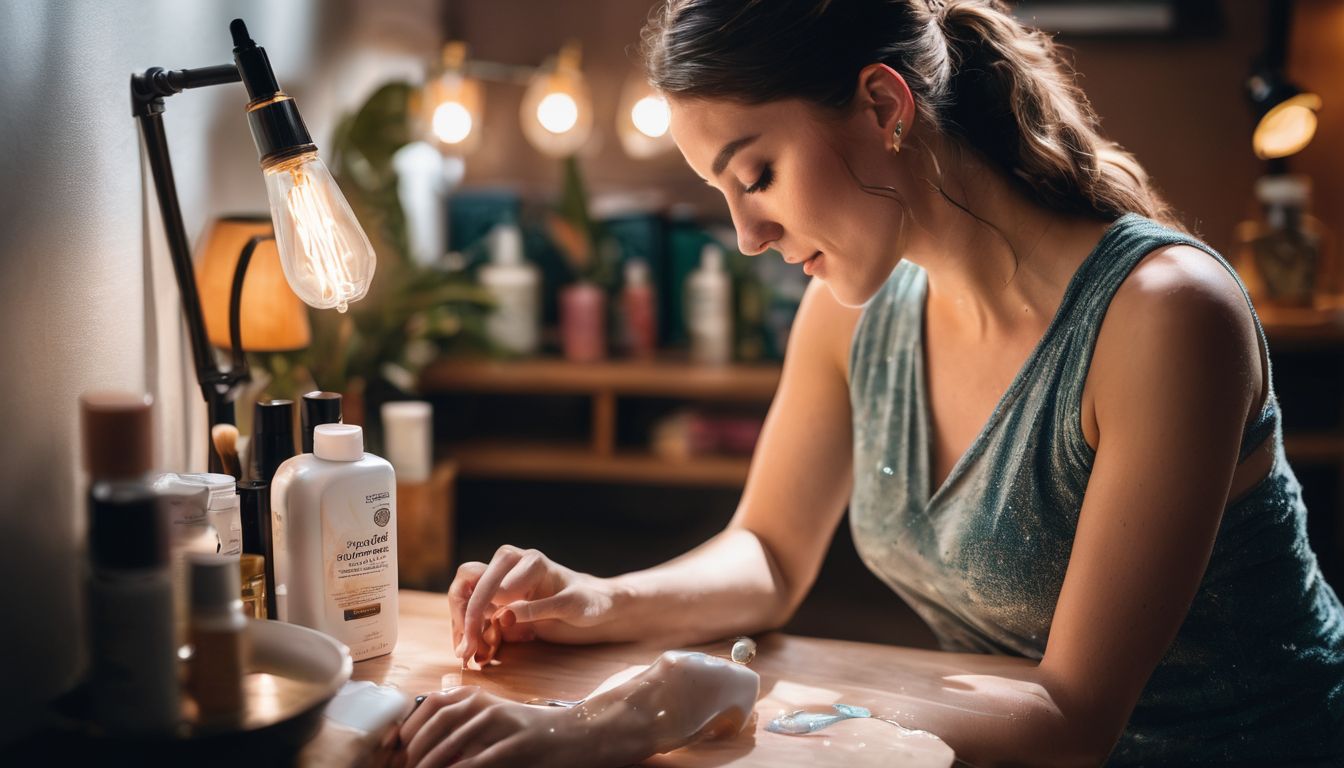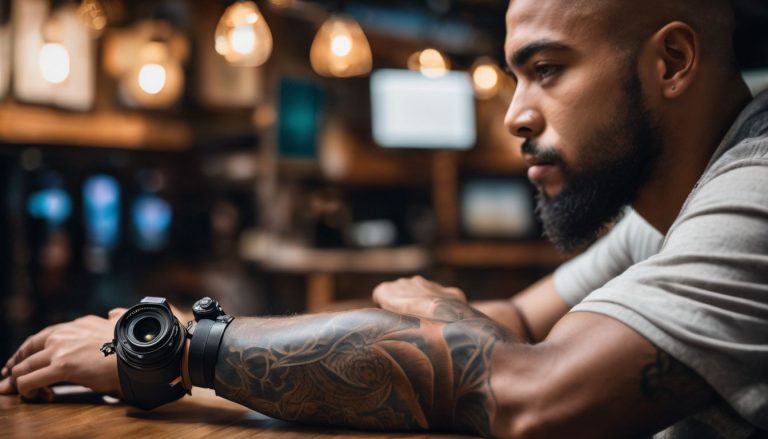The Ultimate Guide to Tattoo Aftercare: Everything You Need to Know
Getting a new tattoo is exciting, but taking care of it can be confusing. Did you know your skin can take up to a month to heal after getting inked? Our guide lays out simple steps for every stage of tattoo aftercare, ensuring your art stays vibrant and healthy.
Dive in for the ultimate tips on keeping your tattoo perfect!
Key Takeaways
- Begin caring for your tattoo right after getting it by gently washing with fragrance – free soap and applying a thin layer of ointment, like Aquaphor or Bacitracin.
- Avoid sun exposure, tight clothing, swimming pools, hot tubs, and any activities that could cause excessive sweating to prevent infection and irritation during the healing process.
- Keep an eye out for signs of complications such as unusual redness, swelling, discharge or fever; seeking medical attention if these occur is important.
- To maintain long – term vibrancy of your tattoo, continue to protect it from the sun using SPF 30 sunscreen and keep the skin moisturized with the right products.
- Regular cleaning with mild soap and proper hydration are key factors in promoting optimal healing and preserving the artwork on your skin.
Why Tattoo Aftercare is Important
Taking care of your new tattoo is critical for preventing infection and preserving the vivid colors and clear lines that make it a work of art. Proper tattoo aftercare ensures that the skin heals properly without complications such as scarring or allergic reactions.
It also helps maintain the design’s integrity over time, keeping your ink looking fresh and vibrant for years to come. Keep in mind, gentle cleaning with mild soap keeps bacteria at bay while applying an approved moisturizer like Aquaphor or Bacitracin protects against dryness during those first crucial days.
Neglecting these steps can lead to faded tattoos, prolonged healing times, and even permanent damage to your skin. So stick to a diligent aftercare routine; it makes all the difference between a great-looking tattoo and one that requires touch-ups later on.
Next up: navigating through the critical first 30 days after getting your tattoo which comes with its own set of detailed guidelines for optimal healing.
The First 30 Days of Tattoo Aftercare
After getting a new tattoo, it’s crucial to properly care for it during the first 30 days to ensure proper healing. From the initial day of getting your tattoo to the end of the first month, each stage requires specific aftercare steps to keep your tattoo looking its best.
Day 1
Tattoo aftercare begins immediately after getting inked. Apply a thin layer of Aquaphor or Bacitracin to the tattoo and cover it with a clean, non-stick bandage for the first few hours.
Gently wash the tattoo with mild soap and water after removing the bandage, then pat dry and apply a fresh layer of ointment. Keep the area clean and avoid rubbing or picking at the tattoo.
Drink plenty of water to stay hydrated and aid in the healing process.
The initial 24 hours are crucial for setting up a healthy healing environment for your new tattoo. It’s essential to follow these steps diligently to promote proper healing and reduce any risk of infection as your skin mends from this procedure.
Days 2-3
As the healing process continues, you may notice some mild swelling and redness around your tattoo during days 2-3. This is normal and can be managed by gently applying a cold compress to the area for 10-15 minutes at a time.
It’s crucial to continue washing your tattoo with unscented soap and lukewarm water twice daily, patting it dry with a clean paper towel afterward. Remember to avoid exposing your tattoo to direct sunlight or soaking it in water, as these activities can hinder the healing process.
Applying a thin layer of fragrance-free moisturizer containing ingredients like shea butter or cocoa butter will help soothe any itching or discomfort. Make sure not to over-moisturize, as too much product can clog pores and delay healing.
Days 4-6
During days 4-6 of the tattoo healing process, continue to keep your tattoo clean and moisturized with a thin layer of Aquaphor or Bacitracin applied 2-3 times a day. It is important to gently wash the tattoo with mild soap and water, then pat it dry with a clean towel before applying the ointment.
Avoid picking at any scabs or peeling skin on your tattoo during this stage to prevent scarring and infection. Remember to stay hydrated by drinking plenty of water, as this supports overall health and improves skin elasticity for proper healing.
Also, be mindful of avoiding prolonged sun exposure by wearing protective clothing or using sunscreen over your tattoo when going outside.
Days 6-14
During days 6-14, continue to keep your new tattoo clean and moisturized. Apply a thin layer of Aquaphor or Bacitracin 2-3 times daily to keep the tattooed area hydrated and protected against infection.
It’s crucial to avoid picking at any scabs that may form during this stage, as it can lead to scarring and interfere with the healing process. Additionally, be mindful of sun exposure and consider covering the tattoo with clothing or using sunscreen when going outdoors.
As the tattoo heals, expect some flaking and peeling in areas where the skin was most stressed during the tattooing process. This is a normal part of the healing process but should not be picked at or forcibly removed.
Proper aftercare during these days helps ensure that your tattoo heals well without complications, so stay diligent in maintaining good hygiene and avoiding activities that could cause irritation to your new ink.
Days 15-30
As the healing process progresses, it is important to continue keeping your tattoo clean and moisturized during days 15-30. Switch from using ointment to a fragrance-free lotion or cream to keep the skin hydrated.
Also, be mindful of any signs of infection such as increased redness, warmth, or discharge around the tattooed area. It is crucial to protect your tattoo from sun exposure by applying sunscreen whenever going outside.
During this period, avoid soaking in hot tubs or swimming pools to prevent potential infection and irritation. Wear loose clothing made from breathable fabrics that won’t rub against the tattoo and disrupt the healing process.
Long-Term Tattoo Aftercare Tips
Proper cleaning and moisturizing are essential for long-term tattoo aftercare. Selecting the right skincare products and avoiding sun exposure and strenuous activities can help maintain the vibrancy of your tattoo.
Selecting the Right Skin Care Products
Choose tattoo aftercare products carefully by considering the ingredients and their potential impact on the healing process. Look for products that are fragrance-free, hypoallergenic, and specifically formulated for sensitive skin to reduce the risk of irritation or allergic reactions.
Opt for gentle, non-abrasive cleansers and moisturizers designed to support skin repair without causing additional trauma to the tattooed area. Be mindful of using products with harsh chemicals or artificial dyes as they can disrupt the healing process and compromise the vibrancy of your new tattoo.
Prioritize natural ingredients like aloe vera, coconut oil, shea butter, and vitamin E which are known for their soothing and nourishing properties.
When selecting ointments or balms, consider options such as petroleum jelly or specialized tattoo aftercare ointments containing antibacterial components to protect against infection while promoting optimal skin hydration.
Proper Cleaning and Moisturizing
After selecting the right skin care products for your new tattoo, it’s crucial to follow proper cleaning and moisturizing techniques. Gently wash the tattooed area with fragrance-free soap and lukewarm water twice a day to remove any dirt or bacteria that could lead to infection.
Pat the tattoo dry with a clean paper towel, avoiding rubbing or using a cloth which could irritate the skin. Once dry, apply a thin layer of fragrance-free moisturizer to keep the area hydrated and promote healing.
Avoid over-moisturizing as this can clog pores and hinder the healing process.
During initial healing, avoid swimming or soaking in water as it can soften scabs and increase the risk of infection. As your tattoo heals, continue to moisturize regularly while being mindful not to overexpose it to water or sun.
Avoiding Sun Exposure and Strenuous Activities
During the initial stages of tattoo aftercare, it is crucial to avoid prolonged sun exposure and strenuous activities to facilitate proper healing. Sun exposure can cause fading and damage to the tattoo, so it’s essential to shield it from direct sunlight.
Apply a broad-spectrum sunscreen with an SPF of at least 30 over the tattooed area when heading outdoors. Additionally, staying away from activities that involve excessive sweating or friction against the new tattoo will aid in preventing irritation and potential infection.
Following these precautions helps protect the integrity of the fresh ink and supports its healing process.
It’s important not to engage in rigorous physical activities such as swimming, heavy lifting, or contact sports during the initial healing period as they can impede proper recovery by causing excessive stress on the newly inked skin.
Common Complications During the Healing Process
Complications such as infection, allergic reactions, and scarring can occur during the tattoo healing process – read on to learn how to identify and address these issues.
Infection
Infection is a serious complication during the tattoo healing process. It is crucial to keep the tattooed area clean and dry to prevent bacteria from causing an infection. Signs of an infected tattoo include excessive redness, warmth, swelling, and pus or fluid discharge.
If any signs of infection are noticed, it’s important to seek medical attention promptly to avoid complications.
Using proper aftercare products like gentle antibacterial soap and ensuring good hygiene can help in preventing infections. Additionally, avoiding submerging the tattoo in water for prolonged periods can reduce the risk of introducing bacteria into the healing skin.
Allergic Reactions
During the healing process, it’s crucial to be aware of potential allergic reactions that can occur with new tattoos. Allergic reactions may present as redness, swelling, itching, or rash around the tattooed area.
To avoid triggering an allergic response, it is important to select hypoallergenic skincare products and ointments specifically designed for tattoo aftercare. Additionally, it’s essential to carefully read the ingredient lists of any products used during aftercare to avoid potential allergens like fragrances, dyes, or common irritants.
To further minimize the risk of allergic reactions during tattoo aftercare, consider doing a patch test on a small area of skin before applying any new product over the whole tattooed area.
Scarring
Scarring is a common concern during the tattoo healing process. It is essential to avoid picking or scratching the tattoo to prevent damage and potential scarring. Proper aftercare routines, such as using recommended moisturizers and avoiding sun exposure, can help minimize the risk of scarring.
Additionally, staying hydrated supports overall skin health and elasticity, aiding in the prevention of any permanent scarring. Understanding that disciplined aftercare is vital for both short-term healing and long-term maintenance will play a crucial role in minimizing the potential for scarring.
Understanding how to properly care for your new tattoo can significantly impact its outcome. Taking necessary precautions for effective aftercare will ensure optimal results and reduce the chances of complications down the line.
Frequently Asked Questions and Tips for Proper Aftercare
Get answers to common questions about when to start aftercare, proper aftercare routines, avoiding certain products and activities, signs of an infected tattoo, and how to safeguard your tattoo.
Plus, get tips for the best ways to care for your new ink.
When to Start Aftercare
To start aftercare for your new tattoo, it is crucial to begin immediately after the completion of the tattooing process. Proper aftercare from day one sets the foundation for a healthy healing process.
The first step involves gently cleaning and applying a thin layer of a recommended ointment or moisturizer to aid in the initial healing stages of your tattoo. As per professional recommendations, this careful approach ensures that your skin remains clean and protected during these critical early days.
Selecting appropriate products for long-term care also plays a vital role in maintaining your tattoo’s vibrant appearance. Understanding when to start aftercare will help you achieve optimal results throughout the healing journey and beyond, ensuring your investment lasts a lifetime.
Proper Aftercare Routine
Proper tattoo aftercare routine is crucial for ensuring optimal healing and long-term maintenance. Keep the tattoo clean by washing with a mild, fragrance-free soap and water 2-3 times daily.
Gently pat it dry with a clean towel to prevent irritation or infection. Apply a thin layer of tattoo-specific moisturizer several times a day to keep the skin hydrated, promoting faster healing.
Avoid exposing the tattoo to direct sunlight and always wear sunscreen when going outside to protect against fading and skin damage. Stay away from tight clothing that can rub against the tattooed area, causing discomfort or slowing down the healing process.
To safeguard your new tattoo, follow these essential steps for proper aftercare routine.
Avoiding Certain Products and Activities
When caring for a new tattoo, it is important to avoid certain products and activities that may hinder the healing process. Harsh chemicals found in some skincare products can irritate the tattooed area and impede healing.
Additionally, rough fabrics or tight clothing can rub against the tattoo and cause irritation, so it’s best to opt for loose-fitting and breathable clothing during the healing period.
Furthermore, strenuous activities or anything that causes excessive sweating should be avoided as sweat can carry bacteria into the tattooed skin, leading to potential infections. Sun exposure should also be minimized as UV rays can fade the colors of the tattoo and slow down the healing process.
Signs of an Infected Tattoo
Keep an eye out for signs of infection such as excessive redness, warmth, swelling, or pain around the tattoo area. Additionally, if you notice pus or any unusual discharge coming from the tattoo, it may be a sign of infection.
Remember that fever and chills could also indicate an infected tattoo. It’s important to seek medical attention promptly if you suspect your new tattoo is infected to prevent further complications.
Proper aftercare plays a significant role in preventing infections and ensuring a smooth healing process for your new tattoo. By recognizing these signs early on and taking quick action, you can safeguard your tattoo and promote its proper healing and long-term maintenance.
How to Safeguard Your Tattoo
To safeguard your tattoo, it’s crucial to protect it from direct sunlight by wearing loose clothing or applying sunscreen with an SPF of at least 30. Keep the tattooed area clean and avoid submerging it in water for prolonged periods, especially in hot tubs or swimming pools where bacteria can thrive.
Additionally, use recommended moisturizers such as Aquaphor or Bacitracin to keep the skin hydrated and aid in the healing process. Avoid picking or scratching the tattoo to prevent damage and potential infection.
Proper aftercare is essential for maintaining a healthy and vibrant tattoo.
After getting a new tattoo, avoid using harsh soaps, lotions, or chemicals on the area. Regularly apply gentle moisturizer to ensure that the skin remains supple and promotes proper healing.
Conclusion
In conclusion, proper tattoo aftercare is crucial for ensuring the tattoo heals well and maintains its quality. Understanding the different stages of healing and following a disciplined aftercare routine are vital.
Selecting suitable skincare products, avoiding sun exposure, and protecting the tattoo from irritation all contribute to successful aftercare. Being aware of potential complications and knowing how to safeguard your tattoo ensures a smooth healing process and long-term maintenance.
FAQs
1. How do I take care of my new tattoo?
To take care of your new tattoo, follow the tattoo aftercare instructions provided by your artist, apply recommended tattoo moisturizer, and keep the area clean to prevent infection.
2. Can you give tips on healing a tattoo properly?
Sure! For proper tattoo care and healing, gently wash your skin with antibacterial soap, pat it dry, apply healing ointments as suggested, and avoid scratching or picking at the area.
3. What should I use on my tattoo for aftercare?
Use specialized tattoo aftercare products like recommended ointments or moisturizers that promote safe healing and help maintain the quality of your ink.
4. How often should I be cleaning my fresh tattoo?
You should clean your fresh tattoo according to post-tattoo care guidelines which typically suggest washing 2-3 times a day using mild skincare products during the initial healing period.
5. What are some common signs that my tattoo isn’t healing right?
Common signs of improper tatoo healing include excessive redness or swelling beyond normal levels, prolonged pain around the area, or unusual discharge which might indicate an infection; if these occur seek professional advice immediately.







